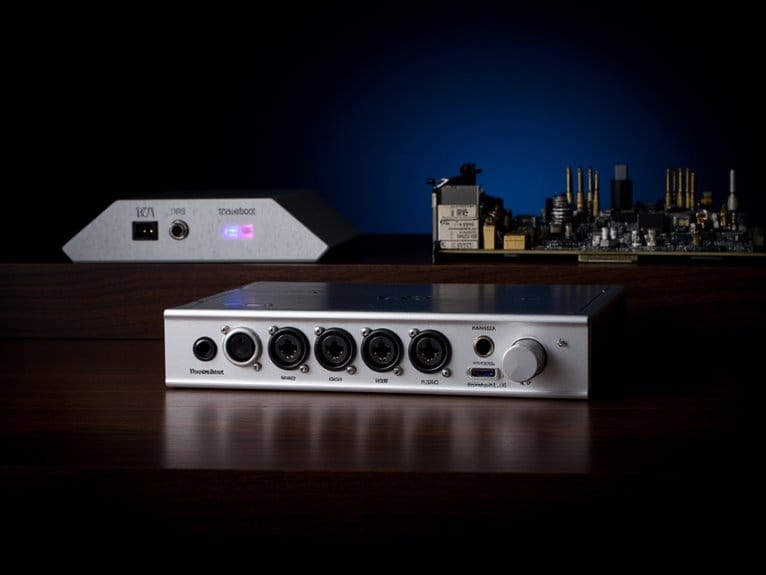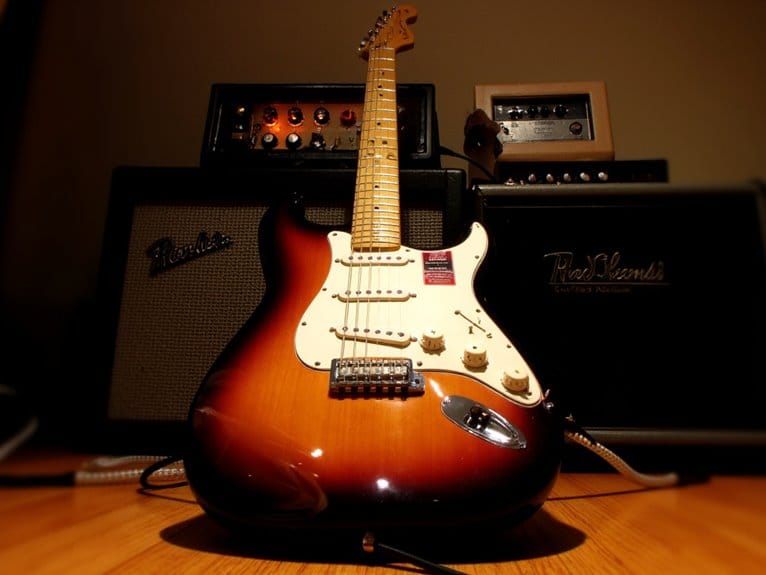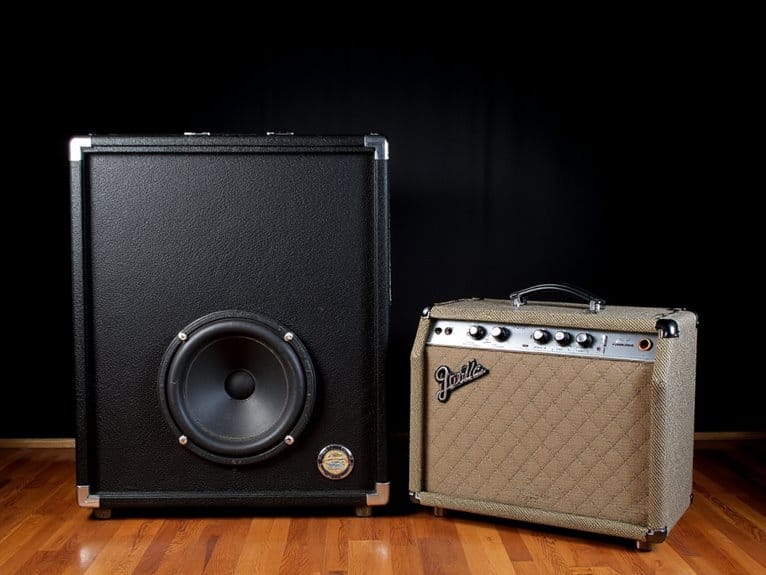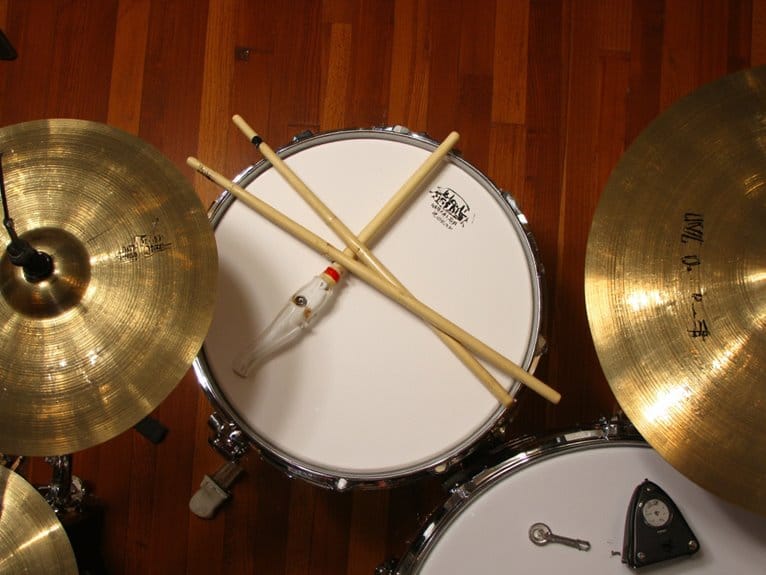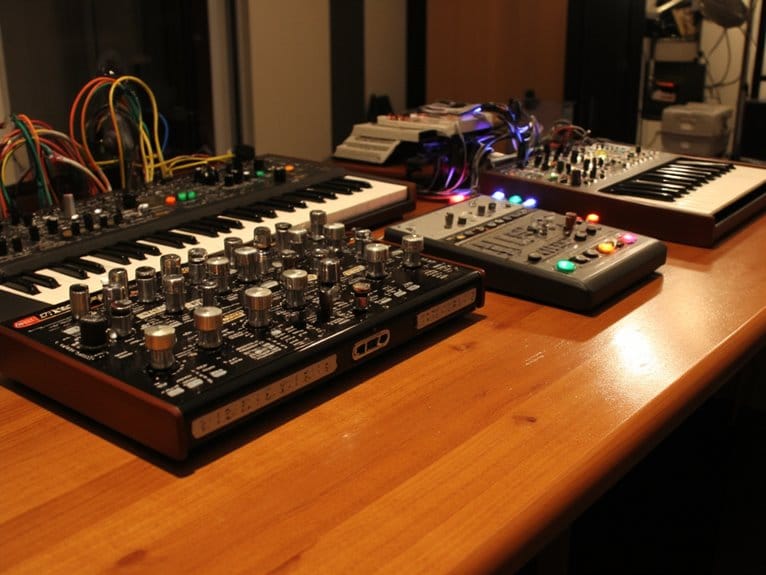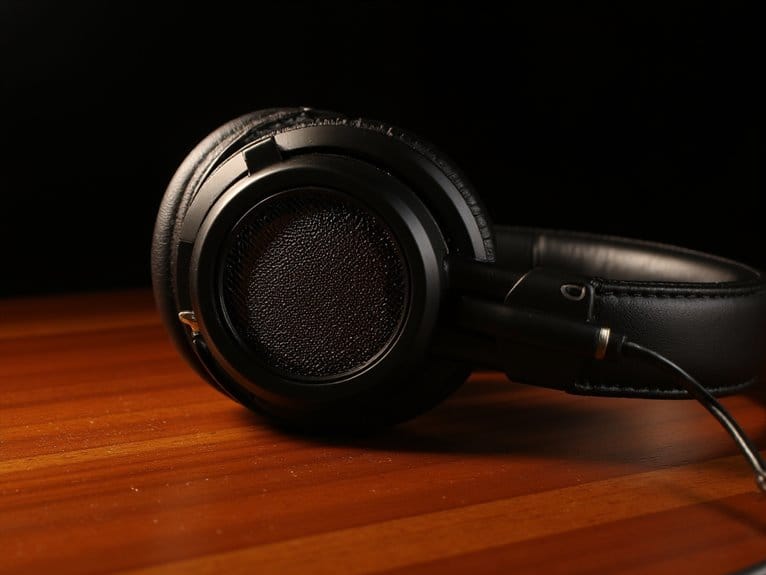Audio Interface Connectivity: USB Vs Thunderbolt Vs PCIE
USB interfaces offer plug-and-play simplicity with 5-7ms latency, making them perfect for home studios and mobile recording, though you’re limited to around 24 channels due to bandwidth constraints. Thunderbolt delivers professional-grade performance with sub-4ms latency and support for 256+ channels, but you’ll pay premium prices exceeding $2,300 for this real-time processing power. PCIe cards provide the lowest latency through direct motherboard integration, handling massive channel counts affordably, though installation requires opening your computer case and limits portability—understanding these trade-offs becomes vital when matching your specific workflow requirements.
We are supported by our audience. When you purchase through links on our site, we may earn an affiliate commission, at no extra cost for you. Learn more.
Notable Insights
- USB interfaces offer affordable, portable solutions with 5-7ms latency, suitable for home studios and budget-conscious creators.
- Thunderbolt provides professional-grade performance with sub-4ms latency, supporting up to 256 channels but requiring higher investment costs.
- PCIe cards deliver the lowest latency through direct motherboard connection, ideal for high-channel desktop studio setups.
- USB uses simple plug-and-play installation while Thunderbolt and PCIe require specialized drivers and more complex setup procedures.
- Bandwidth varies significantly: USB 2.0 handles ~24 channels, USB 3.0 improves multichannel support, Thunderbolt enables hundreds of channels.
Understanding Audio Interface Connectivity Types
When you’re diving into the world of professional audio recording, the connection between your gear and computer becomes the critical bottleneck that’ll make or break your entire workflow.
Understanding audio types and interface standards helps you navigate the maze of connectivity choices, each offering distinct design differences that impact your recording quality.
Performance metrics vary dramatically across Thunderbolt, PCIe, and USB connections, with channel distributions ranging from basic stereo interfaces to expansive 128×128 configurations.
Signal integrity depends heavily on your chosen connection type, as Thunderbolt delivers sub-1ms latency while PCIe leverages direct memory access for even lower delays. Professional audio interfaces excel at maintaining low noise floors during signal conversion, ensuring pristine recordings across all connection types.
Application suitability ultimately determines whether you’ll need portable Thunderbolt flexibility or PCIe’s rock-solid studio performance.
Thunderbolt’s impressive 40 Gbps transfer rates enable professional studios to handle up to 256 I/O channels at 96 kHz sample rates, making it the preferred choice for demanding recording applications.
USB Audio Interface Technology and Architecture
When you’re choosing a USB audio interface, understanding the controller architecture becomes essential because it directly determines how efficiently your audio data travels between your microphones, instruments, and computer.
The USB controller acts as the traffic manager for your audio signals, coordinating the analog-to-digital conversion process while simultaneously managing bandwidth allocation and minimizing latency through sophisticated buffer management systems.
I’ve found that most users don’t realize how the controller’s design affects their recording experience, but factors like USB 2.0 versus USB 3.0 implementation, buffer sizes, and the interface’s internal clock accuracy can make the difference between seamless recording sessions and frustrating dropouts.
Most affordable USB audio interfaces feature plug-and-play setups that work seamlessly with both Mac and Windows computers, eliminating the need for complex driver installations that could complicate your controller architecture.
USB Controller Architecture
At the heart of every USB audio interface lies a sophisticated controller chip that manages the complex dance between your computer’s digital world and the analog domain of microphones, instruments, and speakers.
This controller orchestrates USB data transfer through isochronous protocols, prioritizing continuous audio streams over error correction to maintain real-time performance.
The architecture operates through several critical processes:
- USB endpoints dedicated to input and output audio data streams
- Firmware management handling communication protocols between device and host
- Clock synchronization maintaining steady sampling rates to prevent jitter
- Signal integrity preservation through layered protocol stacks
Your interface’s firmware manages these audio protocols seamlessly, ensuring that when you’re recording that perfect guitar take, the USB controller maintains consistent data flow without dropouts or latency issues.
Bandwidth and Latency
Understanding how your USB controller manages data flow naturally leads us to examine the practical limitations and performance characteristics that directly impact your recording experience.
When evaluating connectivity options, bandwidth allocation becomes essential for interface comparison, as USB 2.0’s 480 Mbps handles most audio transmission needs effectively, while Thunderbolt’s 40 Gbps exceeds typical requirements.
Your latency management depends heavily on buffer sizes and data throughput efficiency, where smaller buffers reduce delay but may compromise system stability.
USB’s CPU-dependent protocol affects performance optimization compared to Thunderbolt’s direct hardware management, which enhances signal integrity.
For most home studios, USB provides adequate bandwidth allocation, though professional setups benefit from Thunderbolt’s superior latency management and reduced system load during intensive audio transmission sessions. USB 3.0’s 5 Gbps transfer rate delivers significantly improved multichannel support and power delivery compared to USB 2.0.
Professional interfaces like the Motu M2 achieve ultra-low 2.5 ms latency through optimized USB-C implementation and efficient driver architecture.
Thunderbolt Audio Interface Technology and Design
While I’ve spent years testing countless audio interfaces across every connection type imaginable, Thunderbolt technology consistently delivers the most impressive combination of speed, versatility, and professional-grade performance that I’ve encountered in modern recording equipment.
These interfaces leverage PCIe protocols for near-zero latency, often achieving round-trip times below 1ms, which makes real-time monitoring practically seamless. The design innovations you’ll find include bus-powered operation, compact ruggedized housings, and integrated tactile controls with LED indicators for precise gain staging.
Signal integrity remains exceptional through high-quality converters providing 115dB dynamic range and ultra-low crosstalk below -110dB.
Key Thunderbolt advantages include:
- Multi-channel capacity – Supporting 4-128 simultaneous input/output channels
- Professional connectivity – ADAT, S/PDIF, AES/EBU, and MIDI integration
- High-resolution support – 24-bit/192kHz sample rates standard
- Flexible monitoring – Dual headphone outputs with intelligent switching modes
PCIe Audio Interface Direct Connection Benefits
When you’re ready to maximize your studio’s performance potential, PCIe audio interfaces deliver the most direct connection possible between your recording equipment and computer’s processing power. Through direct motherboard integration, you’ll experience unmatched connection stability and system performance that eliminates the bottlenecks common with external solutions.
The user experience benefits from exceptional audio fidelity and superior latency comparison results, though installation challenges require technical knowledge that deters casual users. While compatibility concerns limit you to desktop systems with available slots, the efficiency improvements justify cost considerations for professional applications.
The streamlined user interface and reliable data transfer rates make PCIe ideal when you need consistent, high-channel-count recording without dropouts or interference issues. Professional-grade interfaces consistently support 24-bit/192kHz recording resolution to ensure studio-quality audio capture regardless of your connection type. Additionally, these high-end interfaces maintain a dynamic range specification of 106dB or higher to prevent distortion across all sound levels.
Latency Performance Across Connection Types
Beyond the raw connection benefits of PCIe interfaces, you’ll find that latency performance varies greatly across different connection types, with measurable differences that can impact your recording workflow in ways you mightn’t expect.
While USB interfaces typically deliver 5-7 millisecond round-trip latency, Thunderbolt consistently achieves sub-4ms performance, and driver optimization often matters more than raw bandwidth for real-time processing.
Your hardware performance depends on four critical factors:
- Connection stability – Thunderbolt’s peer-to-peer topology outperforms USB’s master/slave architecture
- Performance benchmarks – High-end USB 3 interfaces sometimes match older Firewire latencies
- Audio quality – Converter efficiency impacts perceived delay more than connection type
- User experience – Buffer tuning reduces latency challenges regardless of interface choice
When troubleshooting persistent latency issues, buffer size adjustments in your DAW often provide more immediate improvement than switching connection types entirely.
Bandwidth Limitations and Channel Count Capabilities
As you scale up your recording setup to accommodate larger sessions, bandwidth becomes the silent bottleneck that’ll dictate whether you can capture that 32-piece orchestra or find yourself frantically juggling input limitations.
USB 2.0’s 480 Mbps theoretical bandwidth supports roughly 40 channels at broadcast quality, though real-world audio throughput drops to about 24 channels due to protocol overhead and channel management inefficiencies.
Thunderbolt 3’s 40 Gbps capacity demolishes these constraints, supporting hundreds of channels while maintaining workflow efficiency that matches your performance expectations.
PCIe remains king for massive channel counts, though installation challenges and cost considerations often push users toward external connectivity solutions.
Audio interfaces with multiple XLR inputs enable professional recording setups that can capture full band sessions without the cable-swapping delays that plague single-input configurations.
Your device compatibility needs and user preferences will ultimately determine whether interface innovation justifies the investment over proven USB implementations.
Real-Time Monitoring and Recording Performance
When you’re recording music, the delay between playing your instrument and hearing it back through your headphones can make or break your performance, which is why understanding latency becomes essential for any serious recording setup.
Your interface’s real-time monitoring capabilities directly affect how comfortable you’ll feel during recording sessions, since even a few milliseconds of delay can throw off your timing and create that disorienting “echo” effect that’ll have you second-guessing every note.
I’ve found that optimizing your buffer size settings creates the perfect balance between low latency monitoring and stable system performance, though finding that sweet spot requires understanding how your specific connectivity type handles these demanding real-time tasks.
Latency Impact During Recording
While many musicians focus on choosing the perfect microphone or instrument, latency—the delay between audio input and output—can make or break your recording experience, particularly during real-time monitoring sessions.
Understanding how different interfaces handle this delay becomes essential when you’re trying to capture that perfect take without distracting audio delays.
Your recording workflow directly impacts how latency affects performance:
- Vocalist sensitivity – Even 5-7 milliseconds can throw off timing during vocal recordings.
- Instrumental tolerance – Guitar and piano players typically handle 5-10 milliseconds acceptably.
- DAW settings influence – Your software’s buffer settings dramatically affect perceived delay.
- Driver efficiency matters – Well-optimized interface drivers minimize system-wide latency issues.
Professional interfaces with 16-32 samples typically outperform standard options by delivering superior low-latency performance that meets demanding studio requirements.
Many audio interfaces now include zero-latency monitoring capabilities that provide immediate feedback during recordings without any digital processing delays.
Implementing proper latency compensation techniques while adjusting your monitoring preferences guarantees smooth recording sessions regardless of your chosen connection type.
Buffer Size Optimization
Beyond choosing the right audio interface, I’ve learned that buffer size optimization represents the most critical adjustment you’ll make for achieving professional recording results, directly controlling the delicate balance between real-time monitoring responsiveness and system stability.
Understanding buffer size trade offs becomes essential when you’re balancing CPU load against monitoring latency. I typically start with 256 samples as my baseline, then adjust based on performance needs. Effective latency management techniques require considering your system’s capabilities alongside recording requirements.
Professional audio interfaces support 24-bit/192kHz resolution for high-quality recordings, ensuring your optimized buffer settings translate into superior audio quality throughout your signal chain.
Proper impedance matching throughout your signal chain becomes equally important, as mismatched impedance can introduce unwanted noise and signal degradation that no amount of buffer optimization can fix.
| Buffer Size | Latency (44.1kHz) | Best Use Case | CPU Load | Stability |
|---|---|---|---|---|
| 128 samples | ~3ms | Live recording | High | Moderate |
| 256 samples | ~6ms | General tracking | Medium | Good |
| 512 samples | ~12ms | Mixing sessions | Low | Excellent |
| 1024 samples | ~23ms | Final production | Very Low | Maximum |
| 64 samples | ~1.5ms | Critical monitoring | Very High | Poor |
Expansion Options and Scalability Features
As recording studios evolve from simple setups to complex multi-room facilities, audio interface scalability becomes the backbone that determines whether your system can grow with your ambitions or leave you hitting frustrating bottlenecks.
Digital connectivity transforms expansion from a cable nightmare into streamlined solutions. USB 2.0’s 280 Mbps bandwidth handles moderate channel counts but struggles with larger setups, while USB 3.0’s 3.2 Gbps dramatically improves performance.
However, USB doesn’t support multi-card configurations natively, limiting professional scalability.
Thunderbolt’s 40 Gbps bandwidth and daisy-chaining capabilities create powerful audio network possibilities, allowing multiple interfaces with minimal latency.
Meanwhile, PCIe offers the highest throughput and direct hardware connections, though you’re limited by motherboard slots.
Digital expansion through ADAT Lightpipe and other protocols transforms basic interfaces into complete studio hubs, necessitating careful synchronization for expanded setups.
Key expansion considerations include:
- Channel count requirements for current and future projects
- Bandwidth limitations affecting audio quality and latency
- Physical connectivity constraints in your studio space
- Budget considerations for professional-grade scalability
Hardware Compatibility Requirements
Before you can enjoy seamless audio production, you’ll need to verify your computer system meets specific hardware compatibility requirements that determine whether your chosen interface will function properly.
Your motherboard’s available ports, current operating system version, and power supply capabilities all play vital roles in establishing a stable connection between your audio interface and recording setup.
I’ve learned through years of troubleshooting frustrated musicians that overlooking these fundamental compatibility factors often leads to expensive hardware purchases that simply won’t work with existing systems.
Linux users benefit significantly from USB class-compliant devices that provide plug-and-play performance without requiring additional driver installations through ALSA audio systems.
Motherboard Port Requirements
While selecting an audio interface seems straightforward enough, I’ve learned that your motherboard’s port configuration often determines whether you’ll enjoy seamless recording sessions or wrestle with frustrating compatibility issues.
Motherboard specifications vary dramatically between models, and compatibility standards aren’t always obvious from marketing materials.
Your motherboard’s port ecosystem directly impacts interface performance:
- USB ports require version 3.1 or higher for multi-channel setups, with USB-C offering superior power delivery compared to traditional USB-A connections.
- PCIe slots must match your card’s physical requirements (x4, x8, x16) while providing adequate lane bandwidth for professional applications.
- Thunderbolt compatibility demands specific controller chips integrated into your motherboard’s chipset architecture.
- Analog connections include color-coded 3.5mm jacks supporting various speaker configurations from stereo to 7.1 surround.
Operating System Compatibility
How often have you purchased an audio interface only to discover it won’t work properly with your operating system?
I’ve seen countless musicians struggle with compatibility challenges across different platforms, and honestly, it’s frustrating every time.
Legacy support becomes particularly problematic with FireWire interfaces, which simply won’t function on macOS Big Sur or newer versions, creating significant hardware limitations.
Driver issues plague Windows users especially, where signed driver enforcement and security restrictions can block proper installation.
You’ll often need detailed installation guides and troubleshooting tips to navigate manual configuration settings, particularly on Apple Silicon Macs.
System updates frequently break existing connections, causing performance variances that require immediate attention.
Modern Thunderbolt and USB interfaces generally offer better cross-platform compatibility, though specific drivers remain essential for peak operation.
While many interfaces claim plug-and-play functionality, proprietary drivers are typically needed to unlock full functionality and optimal performance.
Most contemporary audio interfaces provide compatibility with both Mac and PC operating systems, though Windows users may still need to download drivers manually while Mac users often benefit from automatic driver installation.
Power Supply Considerations
The wrong power supply will fry your audio interface faster than you can say “expensive paperweight,” and I’ve unfortunately witnessed this costly mistake more times than I’d care to admit.
Understanding voltage specifications, current draw, and connector types becomes critical when you’re dealing with different interface technologies, as each connection method presents unique hardware requirements and compatibility issues.
Here’s what you need to know about power delivery across interface types:
- USB interfaces rely on 5V bus power with limited current (500mA-900mA), prioritizing power efficiency over processing capabilities.
- Thunderbolt devices typically require dedicated power adapters delivering 12V or higher for advanced DSP features.
- PCIe interfaces draw power directly from your computer’s PSU, ensuring stable high-current supply for professional demands.
- Connector polarity matters – center-positive is standard, and mixing polarities destroys hardware instantly, affecting overall device performance.
When pairing dynamic microphones like the Shure SM7B with your interface, ensure your power supply can support the high phantom power requirements needed for gain boosters and preamps that enhance low-output mic performance.
Professional Studio Vs Home Setup Considerations
When I’m evaluating audio interface connectivity for different environments, I’ve noticed that professional studios and home setups have fundamentally different priorities that directly influence which connection types work best.
Professional environments typically demand high channel counts for complex recording techniques, requiring Thunderbolt or PCIe interfaces that handle multiple microphones, live bands, and surround mixing formats with minimal latency. This studio equipment must integrate seamlessly into rack systems while delivering superior bandwidth for high-sample-rate recording. Higher sample rates can reduce real-time monitoring delay, making them particularly valuable in professional studio environments where latency is critical.
Professional studios require Thunderbolt or PCIe interfaces for high channel counts, complex recording setups, and seamless rack integration with minimal latency.
Home setups, however, prioritize simplicity and affordability, making USB interfaces ideal since they’re plug-and-play, bus-powered, and work with older computers.
You’ll find that while pro studios need advanced DSP processing and robust driver support, home users typically record single instruments or vocals, where USB’s moderate input/output capabilities suffice perfectly. Additionally, bus-powered interfaces are particularly attractive for home recording since they eliminate the need for external power adapters and reduce setup complexity.
Portability and Mobile Recording Factors
Where mobility becomes essential, I’ve found that audio interface connectivity takes on entirely different priorities compared to stationary studio environments, with USB interfaces emerging as the clear winner for portable recording applications.
USB’s bus-powered operation eliminates external power supplies, while its compact form factor fits easily into laptop bags, making field recording scenarios considerably more manageable than I initially expected.
Mobile usability becomes paramount when you’re recording outside traditional studios, and USB interfaces consistently deliver:
- Universal device compatibility across smartphones, tablets, laptops, and desktop systems without driver complications
- Lightweight, shock-resistant designs engineered specifically for travel conditions and outdoor recording environments
- Plug-and-play functionality that bypasses complex setup procedures during time-sensitive recording sessions
- Direct mobile device integration through specialized connectors that support iOS and Android platforms seamlessly
Installation Requirements and Technical Complexity
When you’re ready to set up your audio interface, you’ll quickly discover that installation complexity varies dramatically between USB, Thunderbolt, and PCIe options, with each requiring different levels of technical expertise and hardware modifications.
Your choice between external USB connections that simply plug in, Thunderbolt devices that demand specific ports and driver configurations, or PCIe cards that require opening your computer case will largely determine how much time you’ll spend getting everything operational.
I’ve found that understanding these hardware setup requirements upfront can save you significant frustration later, especially if you’re working with limited technical experience or specific computer configurations that may not support certain interface types.
Hardware Setup Requirements
The foundation of any audio interface setup lies in understanding the specific hardware requirements and installation complexity that varies dramatically across different connection types.
Your user experience depends heavily on managing installation challenges and compatibility issues that align with your user preferences and performance benchmarks outlined in most setup guides.
Here’s what you’ll encounter with each connection type:
- USB interfaces offer plug-and-play simplicity with class-compliant drivers, though you’re limited to 5-meter cable lengths.
- Thunderbolt units require proprietary software installation and specialized cables, but support daisy-chaining multiple devices.
- PCIe cards demand desktop-only installation with case opening, delivering lowest latency for professional applications.
- Power considerations vary from USB bus power to external adapters, affecting your workspace configuration and portability needs.
Technical Installation Complexity
Moving beyond the physical requirements, installation complexity varies greatly between connection types, and I’ve learned that understanding these differences upfront can save you considerable frustration down the road.
USB interfaces offer the simplest experience with straightforward driver installation, often featuring plug-and-play functionality that requires minimal technical knowledge.
Thunderbolt devices need compatible drivers but benefit from native OS support, though firmware updates can occasionally demand manufacturer assistance for troubleshooting issues.
PCIe cards present the most challenging scenario, requiring specialized drivers, manual configuration, and potential BIOS adjustments that might intimidate less technical users.
Cable management remains straightforward for USB and Thunderbolt’s external connections, while PCIe’s internal installation eliminates external cables but introduces static precautions and case accessibility concerns.
Cost Analysis and Value Propositions
Anyone shopping for an audio interface quickly discovers that connectivity type dramatically impacts both your wallet and your workflow, with each connection standard offering distinct value propositions that align with different budgets and professional requirements.
USB limitations include higher latency and fewer features, but entry level selection remains compelling for budget considerations under $500.
USB interfaces sacrifice advanced features for affordability, making them perfect entry points for budget-conscious creators under $500.
Thunderbolt advantages justify premium pricing through real time processing capabilities and superior driver support, though professional needs often demand investments exceeding $2,300.
PCIe scalability offers exceptional latency trade offs through direct motherboard connections, positioning these interfaces in the $200-$4,000 range depending on channel requirements.
Your value assessment should consider:
- USB interfaces – Best for home studios prioritizing affordability over advanced features
- Thunderbolt models – Ideal for professionals requiring DSP processing and low latency
- PCIe cards – Perfect for high channel counts and stable, low-latency performance
- Feature packages – Evaluate included software, phantom power, and expandability options
Choosing the Right Connectivity for Your Workflow
Your connectivity choice fundamentally shapes every aspect of your recording workflow, from the split-second timing that makes or breaks a live session to the simple matter of whether you can actually plug your interface into your computer.
Effective interface selection requires honest assessment of your actual needs versus aspirational ones. Home producers benefit from USB’s universal compatibility and portability, while professional studios demand PCIe’s ultra-low latency and stability for critical tracking sessions.
Thunderbolt bridges both worlds, offering near-PCIe performance with laptop compatibility, though at premium pricing.
Workflow optimization hinges on matching connectivity to your environment—mobile setups favor USB flexibility, fixed studios can leverage PCIe’s raw performance, and hybrid workflows often justify Thunderbolt’s versatility despite higher costs.
Frequently Asked Questions
Can I Daisy-Chain Multiple Audio Interfaces Using Thunderbolt Connectivity?
You can absolutely daisy-chain multiple Thunderbolt audio interfaces, though daisy chain limitations depend on your specific gear and Thunderbolt configurations.
I’ve seen setups where four Antelope Orion32+ units create 128-channel monsters, but you’ll need interfaces with proper passthrough ports and driver support.
Single-port units like Focusrite Clarett must sit at the chain’s end, and you’ll want shorter cables to minimize latency issues.
Do Audio Interface Drivers Affect Latency Performance Differently Across Connection Types?
You’ll find that driver optimization dramatically impacts latency measurement across different connection types, with well-coded PCIe drivers consistently delivering sub-5ms performance while poorly optimized USB drivers can double your latency compared to Thunderbolt equivalents.
I’ve noticed that driver quality often overshadows raw bandwidth advantages, meaning you can achieve professional-grade latency with excellent USB drivers that actually outperform mediocre Thunderbolt implementations.
Will Using USB Hubs Impact Audio Interface Performance and Reliability?
USB hubs can impact your audio interface‘s performance, though I’ve found the effects are often minimal with quality equipment.
You’ll want to prioritize powered hubs for reliable audio quality, as unpowered ones may cause noise or dropouts.
Hub compatibility varies considerably between manufacturers, so investing in professional-grade hubs guarantees stable connections and adequate power delivery for demanding interfaces requiring phantom power.
Can PCIE Audio Interfaces Work With External GPU Setups?
You’ll face significant PCIe compatibility challenges when trying to connect audio interfaces through external GPU setups, as these enclosures aren’t designed for sound cards.
External GPU limitations include inadequate driver support, bandwidth restrictions, and latency issues that’ll compromise your audio performance.
Most eGPU docks won’t recognize PCIe audio devices properly, and even if they do, you’ll likely encounter stability problems that make this approach impractical.
Do Different Operating Systems Favor Specific Audio Interface Connectivity Types?
Yes, different operating systems definitely show clear preferences for specific connectivity types based on OS compatibility factors that’ll influence your interface selection.
macOS strongly favors Thunderbolt due to native driver support and widespread port availability, while Windows works best with USB interfaces for universal compatibility.
Linux users should stick with USB since Thunderbolt and PCIe often require complex custom configurations that aren’t practical for most setups.
On a final note
Your choice ultimately depends on your specific needs, budget, and workflow requirements. If you’re mobile recording or starting out, USB offers the best balance of affordability and convenience. For professional studios demanding ultra-low latency and high channel counts, Thunderbolt delivers superior performance despite higher costs. PCIe remains the champion for dedicated desktop setups requiring maximum bandwidth and rock-solid stability for complex productions.

